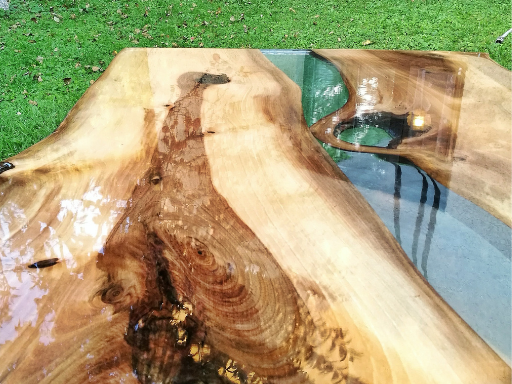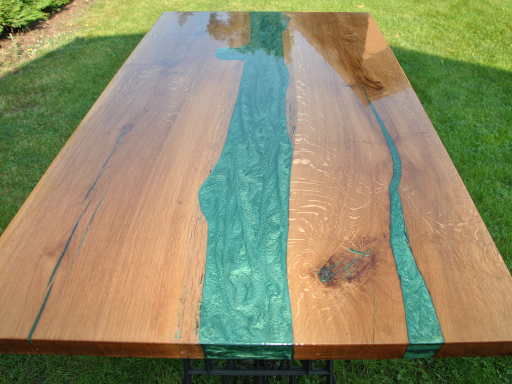The sure way to ruin your beautiful, shiny epoxy table-top that you have spent hours and hours of work making and perfecting is to place it outside and let the sun and standing rain water remaining on the surface. Cured epoxy is a hard, durable, hydrophobic, oleophobic and inert material (resistant to acids, alkalis, solvents and other chemicals) with good abrasion and corrosion resistance. However, it is not able to withstand strong sunlight, even if you add mica powders or pigments to the epoxy. (In addition to UV radiation, it is also necessary to pay attention to the outdoor temperature, so that the sharp direct sun on hot days does not heat the epoxy to the temperature of the glass transition, which would cause the epoxy to soften – therefore it is advisable to shield epoxy tables for outdoor applications with pergolas etc., so that this danger as eliminated the most.)
How does sunlight damage epoxies? Is epoxy resin UV resistant?
When you expose epoxy resin to continuous UV radiation, it degrades, manifesting as discoloration of the epoxy surface, yellowing, dulling and loss of gloss. In another and more extreme case, the epoxy resin becomes completely opaque – chalky and essentially loses its strength properties. Any epoxy (like anything else) ages and degrades, and this shows up in the yellowing of the epoxy. It is a natural phenomenon and the nature of the epoxy bond. What matters is how long it takes for it to turn yellow and what shade the yellowing reaches. There are resins on the market with very high UV resistance, where yellowing to a very subtle yellowish of shade takes only a few years, as well as epoxy resins that yellow to a rich yellow color within months. In order for the epoxy to be as UV resistant as possible, it cannot be cheap, because the formula must contain substances that block UV radiation, etc.
So, how to extra protect your epoxy projects?
So how do you protect your epoxy projects exposed to external conditions from UV damage, so that with proper maintenance, their beauty will last for years? How to extend their life? The solution is a suitable UV-stable clear coat that will help protect the surface of your work. This is important not only for outdoor epoxy surfaces, but it is also suitable for epoxy surfaces in rooms with lots of natural light. Some epoxies, such as Veropal UV PLUS 100 with maximum UV stability or Veropal Transparent 200 with high UV stability, are formulated to help resist damage from UV exposure as much as possible, but even these types of epoxies experience slight yellowing over time (in years) to slightly yellowish shade. Therefore, especially for outdoor applications, we recommend increasing the resistance to UV radiation by applying a suitable type of clear topcoat stable to UV radiation.
We recommend clear coat LV CC 250 as a suitable surface treatment that increases the protection of hardened epoxy both against mechanical damage (scratching) and against UV radiation, which will more than double the life of your work. LV CC 250 clear coat is a two-component PUR acrylic coating with nanosilicon content (for greater abrasion resistance), which after application creates a top thin transparent layer with higher resistance to mechanical scratching (up to 30 %) and higher UV stability. It has a food contact certificate, so it is very suitable for the treatment of table tops and products that come into contact with food. It is ideally applied by spraying at a thickness of 50-80 μm, it dries in 4 hours at 20 °C and the coverage is between 6-8 m2/l. It can be adjusted for both brush and roller application (however, spray application is the best in terms of the final appearance). In case you do not have suitable painting equipment for painting (compressor, gun, etc.), an interesting alternative for the hobby and professional sector for the application of coatings by spraying can be the Preval kit, which, thanks to its excellent spraying and ease of use, is used for the repair of small defects in professional paint shops.
Procedure of coating by spraying:
- Make sure the epoxy is fully cured before applying the clear coat.
- Lightly sand the epoxy – grit 400 or 600.
- Then clean the surface of sanding dust (vacuum with a vacuum cleaner) and wipe with a lint-free microfiber cloth soaked in LV PC 213 degreaser. Let to dry.
- According to the instructions, mix the clear coat/hardener mixture and dilute it on the nozzle of the spray gun used.
- Apply 1 approx. 30µm layer of clear coat to the cross.
- Leave the solvents to evaporate for about 15 minutes.
- While still wet, spray another approx. 30 µm layer of clear coat crosswise.
- Allow to dry and fully harden.
- BEWARE OF THE EVERYWHERE PRESENT DUST!!!
How long does UV protection last on outdoor epoxy board?
Long-term UV protection for exposed epoxy surfaces depends on how well the UV top coat maintains its UV filtering capabilities. Only absorbed UV light can stop photochemical processes that irreversibly damage the epoxy. Since a surface with a higher gloss reflects more UV radiation than a matt surface, we recommend repeating the application of LV CC 250 clear coat after years if we see signs of surface matting.
NOTE: It is important to keep in mind that UV light is stronger in some latitudes than others, and that it also varies between seasons. This means that UV levels are higher at lower latitudes closer to the equator because UV radiation travels a shorter distance through the atmosphere, so the atmosphere cannot absorb as much harmful UV radiation. Which means more harmful UV rays to damage exposed epoxy surfaces. UV radiation levels are also higher at higher altitudes because there is less atmosphere to absorb UV radiation. In addition, UV radiation levels are higher in spring and summer and lower in winter. So, exposing an epoxy surface outside to the summer sun in Greece for 10 minutes can be equivalent to a month of exposure to the sun outside in the winter in Prague. Therefore, depending on where you live, maintenance sprays may need to be done more often.
If you have any questions about working with epoxy or protecting your epoxy projects from UV rays, give our friendly Epoxio technical support team a call at +420 737 108 685. Share your creative epoxy projects by tagging us on Instagram and Facebook @ epoxy, #mojeepoxio, #veropal, #synpocz – we would like to see what you make!


